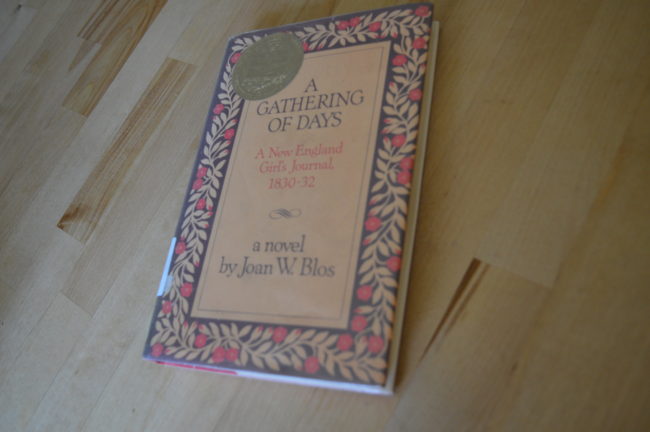
Our 59th Newbery is historical fiction written as the diary of one Catherine Cabot Hall age 13: A Gathering of Days: A New England Girl’s Journal 1830-1832 by Joan W. Blos. In her diary entries, Catherine chronicles two years of going to school, tending the house, caring for her little sister, dealing with her father’s remarriage, coping with the death of her best friend, and helping a runaway slave in the middle of winter.

What I liked. I think my favorite image of the book was Catherine having to work hard to make a new quilt to replace the one she secretly gave to the runaway slave. Her new step-mother teaches her the long, careful process of cutting out the fabric and sewing together the blocks. Only after the months of working on her new quilt does Catherine understand how much she had given away. (And it’s helpful for the reader to understand as well, since giving a blanket away seems like a small gesture to us today. But giving away a handmade quilt is a little like if we gave someone a $700 parka.) It’s a meaningful part of Catherine’s learning to accept her Bostonian step-mother’s skills and wisdom. Also, there is a very sweet exchange with her father about the quilt at the very end of the book.

What was interesting. In the very beginning of the book, Catherine as an old woman writes her great-grand daughter a note saying that she wants her great-granddaughter to have this journal from the time that her father remarried and her best friend died. Which, besides helping the runaway slave, her father remarrying and her best friend Cassie dying are the two biggest plot points in the book. So it’s interesting that the author Joan Blos wanted to preview these life-changing events before the book started. With the father’s remarriage, I thought that he might marry a different woman (Lucy), so the opening inscription served as a way to throw us off the trail, and foreshadow the rather abrupt marriage of the new step-mother that the father met while selling his goods at his annual visit to the big city. With the death of Cassie, I think it prepared readers (and made them worried about the different small sicknesses Cassie had leading up to her death). It was a very different experience reading about that death compared to Bridge to Terabithia which has a very surprising and jolting death of the female best friend as well.

What were some limitations. I think this is more the flip side of the great strength of the book, but writing the book as a journal adds a layer of difficulty. The journal form with its abbreviations and short entries limits the scope of the story and might be a little bit distracting and hard to decipher for some readers. But, the extra challenge is not necessarily hard for readers in a bad way. I think that kids would feel accomplished reading the journal with its occasional arcane phrases and short hand (and I think it gets easier once you’re into the flow of the book). Still, it’s not the only way to write historical fiction. There are many ways historical fiction can give you a sense of the language of the time without the same journal form (Catherine Called Birdie and May B come to mind as two of my favorite books that do this).

I did wonder what the purpose of the italicized phrases was, and if that was trying to reproduce someone underlining something in their journal. When I was in graduate school, I had to take a class called paleography (the study of old handwriting; it was definitely one of the best things I got to do in grad school) and there are all sorts of interesting ways that a handwritten document can get transcribed (i.e. typed up) to try and convey what the original manuscript contained. (Something added later, something crossed out, something abbreviated etc.). In some ways I think it would be neat to have a newer edition of the book that did more with font and text to provide kids a closer experience to actually reading a handwritten journal.

Similarity to other Newbery winners. In terms of historical setting, it reminds me most of Invincible Louisa and Caddy Woodlawn, all 19th century rural America books with young female leads. In terms of trying to be a really accurate historical novel it was a bit like Johnny Tremain, Island of the Blue Dolphins, Amos Fortune, Free Man, and Carry On Mr. Bowditch. In terms of theme and content, it reminded me most of Up A Road Slowly and The Witch of Black Bird Pond with a young girl coming to terms with the death of her mother.

What it teaches me as a writer. One thing I’ve noticed about children’s books that I really love is when they go into some technical detail about something I don’t know how to do. In this case, it was quilting, but in other books, it’s sailing, or baking, or washing dishes in a river. I tend, when I write, to think that that kind of detail would be boring, but I think children like to feel competent and smart as they read, whether that’s solving a mystery with the clues that the sleuth has been given, or knocking out a troll with a handful of magic spells, or piecing together a quilt.
Have you read A Gathering of Days? What are your favorite books about pioneer days?
*Note* This post contains Amazon affiliate links, which means if you were to buy a book, I’d get a tiny commission at no cost to you. Thanks for supporting Stories & Thyme!*
